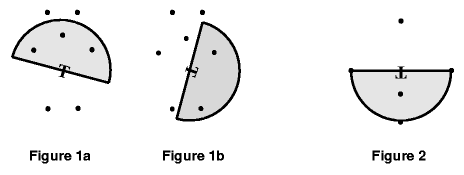POJ 1106 Transmitters(叉积)
2014-09-29 17:30
501 查看
Transmitters
In a wireless network with multiple transmitters sending on the same frequencies, it is often a requirement that signals don't overlap, or at least that they don't conflict. One way of accomplishing this is to restrict a transmitter's coverage area. This problem uses a shielded transmitter that only broadcasts in a semicircle. A transmitter T is located somewhere on a 1,000 square meter grid. It broadcasts in a semicircular area of radius r. The transmitter may be rotated any amount, but not moved. Given N points anywhere on the grid, compute the maximum number of points that can be simultaneously reached by the transmitter's signal. Figure 1 shows the same data points with two different transmitter rotations.  All input coordinates are integers (0-1000). The radius is a positive real number greater than 0. Points on the boundary of a semicircle are considered within that semicircle. There are 1-150 unique points to examine per transmitter. No points are at the same location as the transmitter. Input Input consists of information for one or more independent transmitter problems. Each problem begins with one line containing the (x,y) coordinates of the transmitter followed by the broadcast radius, r. The next line contains the number of points N on the grid, followed by N sets of (x,y) coordinates, one set per line. The end of the input is signalled by a line with a negative radius; the (x,y) values will be present but indeterminate. Figures 1 and 2 represent the data in the first two example data sets below, though they are on different scales. Figures 1a and 2 show transmitter rotations that result in maximal coverage. Output For each transmitter, the output contains a single line with the maximum number of points that can be contained in some semicircle. Sample Input 25 25 3.5 7 25 28 23 27 27 27 24 23 26 23 24 29 26 29 350 200 2.0 5 350 202 350 199 350 198 348 200 352 200 995 995 10.0 4 1000 1000 999 998 990 992 1000 999 100 100 -2.5 Sample Output 3 4 4 Source Mid-Central USA 2001 |
#include<iostream>
#include<cstring>
#include <algorithm>
#include<cmath>
using namespace std;
struct p{
double x;
double y;
}Point[1005];
double x,y,r;
bool f(double u,double v){
double rr=(u-x)*(u-x)+(v-y)*(v-y);
if(rr<=r*r)
return 1;
else
return 0;
}
int main(){
while(cin>>x>>y>>r){
if(r<0)
return 0;
int n;
cin>>n;
double u,v;
int count=0;
for(int i=0;i<n;i++){
cin>>u>>v;
if(f(u,v)){
Point[count].x=u;
Point[count].y=v;
count++;
}
}
int max=0;
for(int i=0;i<count;i++){
double x1=Point[i].x;
double y1=Point[i].y;
int loop=0;
for(int j=0;j<count;j++){
if(i!=j){
if(((x1-x)*(Point[j].y-y)-(Point[j].x-x)*(y1-y))>0)
loop++;
}
}
loop=(loop>=(count-loop))?loop:(count-loop);
max=max>loop?max:loop;
}
cout<<max<<endl;
}
return 0;
}
相关文章推荐
- POJ 1106 Transmitters(计算几何:叉积)
- poj 1106 Transmitters (计算几何,叉积||极角排序)
- (poj step8.1.1.1)POJ 1106 Transmitters(判断一条边在另一条边的哪一个方向——计算叉积)
- Poj 1106 Transmitters
- poj1106-Transmitters 几何覆盖问题
- POJ1106(叉积应用)
- POJ 1106 Transmitters
- POJ 1106 Transmitters (几何覆盖问题)
- POJ 1106 Transmitters(计算几何 极角排序啊)
- POJ 1106 Transmitters
- POJ 1106 Transmitters
- POJ 1106 Transmitters
- ZOJ 1041(POJ 1106) Transmitters(…
- zoj 1041 || poj 1106 Transmitters
- POJ 1106 Transmitters 已被翻译
- poj 1106 Transmitters
- poj 1106 Transmitters(极角排序)
- POJ-1106 Transmitters解题报告
- POJ 1106 Transmitters 计算几何
- POJ 1106 Transmitters
